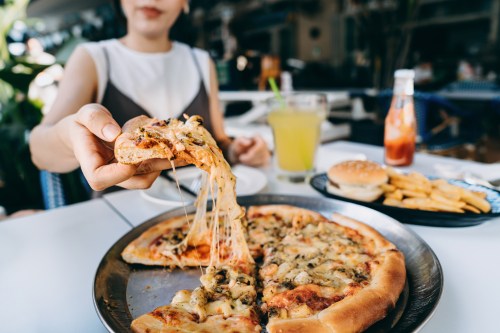We’re all doing the best we can with the knowledge we have—and when you’ve got the education and credentials required for the “RD” letters to live behind your name, that wellness knowledge is pretty major. So it comes as little surprise that when on track to becoming a registered dietician, a person’s eating habits may change or develop to better reflect what they’re learning.
Experts in This Article
registered dietitian and author of Smoothies &
registered dietitian and author of The Better Period Food Solution.
From drilling down the importance of fatty fish (and the benefits of omega-3 fatty acids) and cruciferous vegetables to opting for organic dairy, we spoke with four leading registered dietitians and asked them to single out the foods and habits they adopted since becoming dieticians. Here are 10 foods registered dietitians love and are a must for your weekly grocery shopping list.
10 Foods Registered Dietitians Always Eat
Frances Largeman-Roth, RDN, author of Smoothies & Juices:
1. Alaskan Salmon
“After completing my undergraduate degree in human nutrition at Cornell, I moved to New York City to do my dietetic internship at Columbia. During the program, I learned so much and my eating habits changed quite a bit. I had been a vegetarian for years, but learning about the benefits of omega-3 fatty acids in fatty fish made me put seafood back on the menu. I didn’t have a kitchen in my student housing, so I would buy cooked pieces of wild Alaskan salmon, which is always wild-caught and sustainable. I swear the protein, DHA, and vitamin D in the salmon helped me get through my first New York winter and finals.”
2. Organic dairy
“Prior to becoming an RDN, I would just buy yogurt based on flavor and fat percentage. But in the process of my education, I started learning about how pesticides are stored in fat—and since I hadn’t had kids yet, I wanted to make sure that I was avoiding pesticides as much as possible. I do buy some conventional dairy, but most of what I buy for my family is USDA organic.”
3. Avocados
“I grew up in Western New York in a small town. We didn’t have a great selection of fresh produce, and I think the first time I tried an avocado was in college. I didn’t start buying it regularly until after my dietetic internship when I moved to San Francisco and started my first job as a dietitian in an integrative wellness clinic. I finally embraced fat—the good stuff—and started including avocados in my weekly grocery shopping.”
Lainey Younkin, MS, RD, LDN, founder of Lainey Younkin Nutrition:
4. Cruciferous vegetables
“While I ate some of these things as a kid, I definitely increased my intake of vegetables like broccoli, cauliflower, Brussels sprouts, kale, and arugula after becoming an RD. I learned that cruciferous vegetables produce compounds like glucosinolates and sulforaphane, which can reduce the risk of cancer by protecting cells from damage and detoxifying the body from harmful compounds. Plus, they’re an excellent source of fiber, which most people aren’t getting enough of. Not only will fiber help keep you regular, it also slows digestion aiding weight loss and maintenance.”
5. Beans, legumes, and whole grains
“Unfortunately, toxic diet culture has made many people fear beans and grains—but when you take a look at the Mediterranean diet, which is the meal regime that those who live the longest follow, they incorporate many beans, legumes, and whole grains. Becoming an RD made me add more beans. Beans are loaded with soluble fiber, which forms a gel in the intestines, slowing digestion and keeping you full. Soluble fiber can also help lower LDL (“bad”) cholesterol. Half a cup of black beans delivers eight grams of fiber and seven grams of protein.”
Megan Ostler, RD, nutrition program director at iFIT:
6. Chia seeds
“These seeds are super nutrient dense and a good source of antioxidants, fiber, omega-3 fatty acids, vitamins, and minerals like calcium, magnesium, potassium, and B-vitamins. While I don’t struggle to get many of these nutrients from other food sources, becoming an RD made me notice that omega-3 fatty acids are a little tough for me, so that was the main driving source for including these more. They are also easy to use. I just sprinkle a tablespoon on my oatmeal, toast, salad, and so on. With my kids I call them ‘sprinkles’ and make it fun to add a super nutrient dense food into our meals.”
7. Arugula
“After getting my RD and learning about the importance of vegetables and particularly leafy greens, I started trying to incorporate them more. I discovered a love for arugula. It’s peppery and delicious on everything! I add it to breakfast sandwiches, salads, soups, pastas, pizza, and more. It is such a versatile vegetable.”
Leslie Bonci, MPH, RDN, CSSD, LDN, founder of Active Eating Advice:
8. California Prunes
“Since becoming a registered dietitian, I like to understand the ‘why’ before I buy; this mindset has helped me eat for taste while achieving the nutritional benefits that I know my body needs. With that said one of the first foods I added to my diet was California prunes because they’re bone and gut protective. They contain polyphenols, fiber, and micronutrients, packing a powerful and preventive nutrition and health punch. Using pureed prunes in baked goods is also a great way to reduce added sugar and fat.”
9. Mushrooms
“Mushrooms are packed with potassium, vitamin D, ergothioneine, beta-glucan, and fiber, making them great for satiety, gut health, and immune health. I like to blend them with meat to add flavor, nutrients, and help cut back on saturated fat. I also like to make mushroom s’mores using portobellos, shredded Asiago, pesto and a tomato bruschetta topping.”
10. Cannellini beans
“Legumes like cannellini beans contain protein, fiber, potassium, and B vitamins. They’re good for gut health, heart health, satiety, and blood glucose management. They are also a low-cost protein option. I like to use them in soups, especially cream-based soups. Pureed beans can add a creamy mouthfeel to dishes while boosting the nutrient density, too. They can also be blended into pasta sauce.”
5 Foods Dietitians Avoid
1. Refined Sugar
According to registered dietitian, Tracy Lockwood Beckerman, RD, high-sugar diets can alter gut bacteria. On an episode of You Versus Food, Beckerman shared that refined sugar stimulates the growth of harmful bacteria, known as candida, that can damage your gut lining.
2. Meat
Aside from the harmful effects the meat industry can have on the environment, Beckerman also urges her clients to reduce meat consumption whenever possible. “Because bacteria changes swiftly in the gut—which can either be a good thing or a bad thing—a meat-heavy diet can lead to negative shifts in bacteria in as little as two days,” Beckerman says.
3. Processed Foods
Though, of course, there’s nothing wrong with a cheat meal here and there, Beckerman explains that highly-processed foods like ones that have a long shelf life or a longer than a CVS-receipt list of ingredients, don’t make the RD-approved cut. According to her, research has linked these foods to a less diverse microbiome that hinders the growth of beneficial gut bacteria.
4. Alcohol
Booze-free is the way to go, according to this registered dietitian. “Heavy drinking has the ability to promote intestinal inflammation and negatively impact the gut. Plus, heavy alcohol intake and overstimulate the intestines,” Beckerman explains. This can lead to bowel discomfort and a lot more time spent on the loo.
5. Over-Processed Vegan Products
Although you might be drawn to buzzy new vegan products, registered dietitians say to be mindful of over-processed foods with a laundry list of ingredients. So, make sure to carefully read the labels on the packaging of these seemingly healthy vegan foods to ensure that all of the ingredients are a-okay and don’t contain an overabundance of saturated fat, sodium, or added sugars.
RD-Approved Foods Meal Prep Plan
Breakfast
Lunch
Dinner
Dessert
This Autumn arugula and squash salad recipe hits all the right notes:
Sign Up for Our Daily Newsletter
Get all the latest in wellness, trends, food, fitness, beauty, and more delivered right to your inbox.
Got it, you've been added to our email list.










